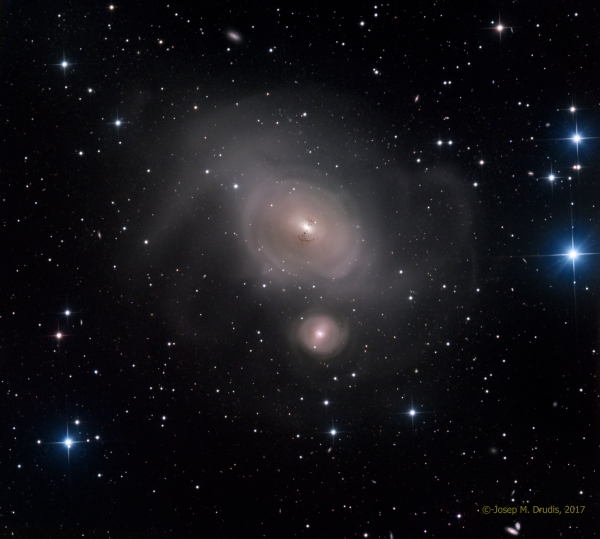
Click here for full resolution image
NGC 1316 is considered to be a lenticular galaxy or an elliptical galaxy in different publications. What we see today is the result of at least one galactic merger, but many authors agree that more than one, several according to most and even probably many galactic mergers have taken place to provide NGC 1316 its current shape. In fact, this galaxy also receives the nickname of “Galactic Killer” (ESO). NGC 1317 is also in this image, just below its gargantuan partner and has not yet been very much influenced by it (although it is already interacting with it). NGC 1317 will ultimately fall into NGC 1316, modifying again its shape.
NGC 1316 is also known as Fornax A. This means that it is the most powerful source of radio emission in that constellation (and the fourth brightest in the whole sky). This radio emission is fueled by the infall of material (gas, dust, stars…) into the supermassive central black hole. The fact that this galaxy has swallowed other galaxies is portrayed by the dark dust lanes that can be seen on its core region as well as the tidal tails and faint rings that can be seen around it. Another evidence of the mergers is the rare presence (on an elliptical galaxy) of several globular clusters around it, most probably belonging to an already cannibalized galaxy.
The images of this galaxy that can be found in the web, usually emphasize its outer envelope, with its delicate loops and arcs, more than its dust lanes of the core region. This image tries to emphasize both. Please see below a comparison of three images (crop of the core region) taken with the MPG/ESO 2.2-metre telescope at ESO’s La Silla Observatory in Chile (left), the usual CDK 20 inch located at SSO (center), Australia and the Hubble Telescope (right).



Additional Information
Object
Name(s): NGC 1316. Fornax A
Type: Lenticular-Elliptical Galaxy
RA: 03h 22m 41s
Dec: -37º 12’ 36”
Constellation: Fornax
Size (arcmin): 11×7
Magnitude: +9.2
Distance: 64 Mly
Image
Date:
Location: iTelescope.net, SSO near Coonabarabran, NSW Australia
Size (arcmin): 35×31.5
Telescope: Planewave CDK 20” f/6.8
Camera: SBIG STX16803 (4096x4096pix)
Guiding: Astrodon MonsterMOAG off-axis guider
Total exposure: 8 hours (L: 2.5h; RGB: 5.5h)
Processing: CCDStack, Photoshop CC 2017